You're using an outdated browser. Please upgrade to a modern browser for the best experience.
Please note this is a comparison between Version 1 by Grzegorz Mentel and Version 2 by Jason Zhu.
Taking into account factors such as unfavorable climate changes, shrinking fossil fuel resources, low energy efficiency, and the pace of population growth, the transformation towards green and renewable energy is one of the most important goals and challenges facing the world. The energy sector is the source of about 75% of global greenhouse gas emissions and energy-related emissions are reaching new record levels. For the energy transition to succeed, innovation at the level of technology, business processes and policies (local, national, and international) are necessary.
- green energy
- renewable energy
- innovation
1. Introduction
Population growth and the accompanying socio-economic development increase the demand for energy and energy-related services, as all societies need such services to meet basic human needs and improve human well-being, and to develop and support production processes [1]. In 2014, the total global consumption of primary energy amounted to approximately 160,310 million MWh, and it was predicted that this value would increase to 240,318 million MWh in 2040 [2]. Global reserves of fossil fuels are depleting very quickly: based on average global usage forecasts, it is assumed that oil and gas may last for 50 more years, and coal and uranium for about 100 more years [3]. Due to the long-term and very intensive use of non-renewable energy sources, there are also harmful effects on the environment, such as air pollution, climate change, and irreversible loss of natural resources.
The UN states that to keep global warming below 1.5 °C, emissions must be reduced by 45% until 2030 and to net zero by 2050 [4]. It is estimated that the energy sector is the source of about three-quarters of global greenhouse gas emissions [5]. Thus, the energy sector plays a fundamental and growing role in achieving the decarbonization of the economy [6]. Therefore, in May 2021, the International Energy Agency (IEA) published its monumental Net Zero by 2050 report, which assumes that the electricity sector must move from being the highest emitting sector in 2020 to the first sector to achieve net zero emissions by 2040 in the world [7]. At the same time, the IEA emphasizes that achieving this goal requires unprecedented efforts by all actors.
Decarbonization of the electricity sector is at the heart of the response to the threat of climate change. Therefore, the Paris Agreement underlines the urgent need for action in this area—in particular, the shift from fossil fuels to renewable energy and increasing energy efficiency [8]. This problem has also been included in the UN Sustainable Development Goals [9]. Goal 7 is to achieve universal access to affordable, reliable, and modern energy and to significantly increase the share of renewable energy in the energy mix. People’s dependence on energy has increased significantly, but energy poverty remains an international development challenge. As energy is a prerequisite for many aspects of modern life, lack of access reflects social and economic inequalities. However, it must be based on low-emission technological solutions that reduce greenhouse gas emissions, and thus improve living and health conditions and ensure sustainable development of life on the planet [9].
However, as the International Renewable Energy Agency (IRENA) highlights in its 2022 Tracking Report on Sustainable Development Goal 7 [10], the latest available data and selected energy scenarios show that at the current pace of progress, the world does not stand much chance of achieving any of the goals and metrics under SDG 7. This is especially true for the most vulnerable groups of countries, which from the beginning have been significantly lagging behind in this area. Worldwide, 91% of the population had access to electricity in 2020, still leaving 733 million people without access to electricity. According to forecasts, the problem of lack of access to electricity in 2030 will still affect 630 million people [11][12][11,12].
‘(…) any form of energy from solar, geophysical, or biological sources that is replenished by natural processes at a rate that equals or exceeds its rate of use. Renewable energy is obtained from the continuing or repetitive flows of energy occurring in the natural environment and includes low carbon technologies such as solar energy, hydropower, wind, tide and waves and ocean thermal energy, as well as renewable fuels such as biomass’.
In many cases, the terms renewable energy and green energy are used interchangeably, but there are important differences between the terms. Green energy is a subset of renewable energy and includes resources that provide more environmental benefits as they come from natural sources such as the sun, water, and wind [14].
The International Energy Agency (IEA) proposes the following classification of renewable energy technologies based on their stage of development:
-
First generation technologies, i.e., hydropower, biomass combustion, geothermal energy and heat;
-
Second generation technologies, i.e., solar heating and cooling, wind energy, bioenergy, solar photovoltaics;
-
Third generation technologies, i.e., thermal solar energy, ocean energy, geothermal energy, integrated bioenergy systems [15].
Globally, it is estimated that in 2008 renewable energy accounted for 12.9% of the total 492 exajoules (EJ) of primary energy supply [14]. Moreover, as the WHO report [16] shows, in 2010–2019 the share of renewable energy sources in total final energy consumption increased by only 2.7%. It was a good sign that although the COVID-19 pandemic had a bad effect on the energy transformation and stopped many green energy projects, in 2020 the use of renewable energy sources continued to grow and accounted for over 80% of all new electricity capacity added that year [17]. However, in 2021, the share of renewable energy sources in global electricity production reached only 28.7% (after a slight increase of 0.4%) resulting from the global electricity demand reaching its all-time high, the slowdown in economic activity caused by COVID-19, and drought in several regions that reduced hydropower production [18].
2. Research Trends
As already signaled in the Introduction, innovation is one of the key elements of achieving SDG 7 and accelerating the development of green and renewable energy. Both from the perspective of science and practice, an in-depth understanding of scientific achievements in the field of green and renewable energy is of key importance [19][37]. The basic criterion for assessing the interest of researchers in a given scientific area and the dynamics of this interest is the number of publications and its distribution over the years [20][21][22][23][24][39,40,41,42,43]. Figure 1 shows the number of published documents on green and renewable energy and innovation in 2012–2022. It is worth noting that there is an increasing trend in the number of scientists researching the topic of innovation in the field of green and renewable energy. This increase is particularly noticeable in the last three years, i.e., during the period of intensified discussions on the climate and energy crisis and the green transformation. As the problem of climate change and dwindling fossil resources becomes more urgent, the authors predict that this trend will continue into the future.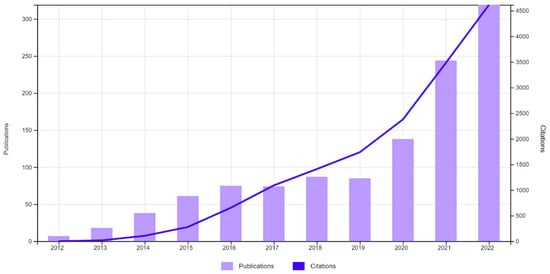
Figure 1. The number of documents on green and renewable energy and innovation and the number of citations of documents (2012–2022).
Table 1. The leading authors of documents on green and renewable energy and innovation.
| Authors | No. of Papers | % of 1144 | Citations |
|---|
Table 2. Top 20 journals with articles on green and renewable energy and innovation.
| Journal | No. of Papers | % of 1144 | Citations |
|---|---|---|---|
| Jahid, Abu | 6 | 0.5245 | 56 |
| Energies | 119 | 10.402 | 961 |
| Anser, Muhammad Khalid | 6 | 0.5245 | 32 |
| Sustainability | 91 | 7.955 | 650 |
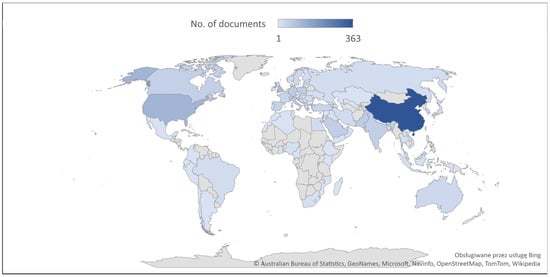
Figure 3. A map of countries in accordance with the number of published articles on green and renewable energy and innovation.
Table 3. Documents on green and renewable energy and innovation by country.
Documents on green and renewable energy and innovation by country.
| Country | No. of Papers | % of 1144 | Citations | |||||
|---|---|---|---|---|---|---|---|---|
| Peoples Republic of China | 363 | 31.731 | 4182 | |||||
| USA | 118 | 10.315 | 3009 | Alsharif, Mohammed H. | 6 | 0.5245 | 27 | |
| IEEE Access | 40 | 3.497 | 551 | |||||
| England | 102 | 8.916 | 2619 | Cabeza, Luisa F. | 5 | 0.4371 | 390 | |
| Environmental Science and Pollution Research | 36 | 3.147 | 281 | |||||
| Italy | 71 | 6.206 | 867 | Ahmad, Mahmood | 5 | 0.4371 | 20 | |
| Frontiers in Environmental Science | 31 | 2.710 | 83 | |||||
| Pakistan | 63 | 5.507 | 814 | Dincer, Hasan | 5 | 0.4371 | 11 | |
| 2.273 | 79 | Yuksel, Serhat | 5 | |||||
| Kharel, Rupak | 4 | 0.3497 | ||||||
| Energy Reports | 26 | |||||||
| Germany | 60 | 5.245 | 1607 | Energy Policy | 190.4371 | 11 | ||
| 1.661 | ||||||||
| Poland | 739 | 55 | 4.808 | 343 | Coma, Julia | 4 | ||
| Economic Research-Ekonomska Istrazivanja | 16 | 0.3497 | 361 | |||||
| 1.399 | ||||||||
| Saudi Arabia | 80 | 54 | 4.720 | 970 | Perez, Gabriel | 4 | ||
| Frontiers in Energy Research | 16 | 0.3497 | 361 | |||||
| 1.399 | ||||||||
| India | 48 | 51 | 4.458 | 525 | Stucki, Tobias | 4 | ||
| Applied Energy | 15 | 0.3497 | 156 | |||||
| 1.311 | ||||||||
| Canada | 845 | 49 | 4.283 | 1197 | Sarkodie, Samuel Asumadu | 4 | ||
| Applied Sciences-Basel | 11 | 0.3497 | 121 | |||||
| 0.962 | ||||||||
| Spain | 73 | 45 | 3.934 | 937 | Asif, Muhammad | 4 | 0.3497 | 119 |
| IEEE Journal on Selected Areas in Communications | 9 | 0.787 | ||||||
| South Korea | 444 | 41 | 109 | |||||
| 3.584 | 667 | Renewable Energy | 9 | 0.787 | 305 | |||
| Turkey | 40 | 3.497 | 643 | Zgid, Dominika | 4 | |||
| Malaysia | 38 | 3.322 | 425 | |||||
| France | 36 | 3.147 | 603 | |||||
| Taiwan | 33 | 2.885 | 190 | |||||
| Netherlands | 29 | 2.535 | 658 | |||||
| Australia | 28 | 2.448 | 365 | |||||
| Sweden | 27 | 2.360 | 357 | |||||
| Switzerland | 23 | 2.010 | 921 |
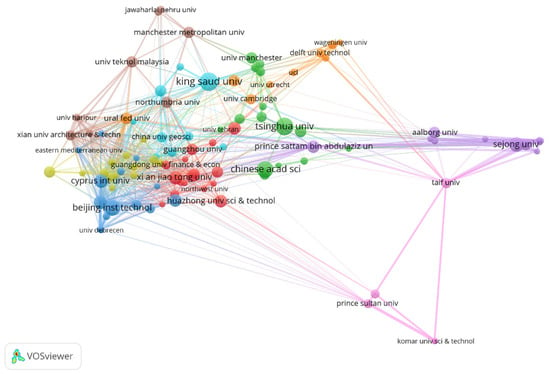
Figure 4. Bibliographic coupling of organizations.
Table 4. Most cited articles.
| Article | Year | Author(s) | Citations | Citations per Year | |||
|---|---|---|---|---|---|---|---|
| Green preparation of reduced graphene oxide for sensing and energy storage applications | 2014 | Bo et al. | 390 | 48.75 | |||
| Energy, land-use and greenhouse gas emissions trajectories under a green growth paradigm | 2017 | van Vuuren et al. | 324 | 64.80 | |||
| Tailoring the energy landscape in quasi-2D halide perovskites enables efficient green-light emission | 2017 | Quan et al. | 316 | 63.2 | |||
| Energy-efficient base-stations sleep-mode techniques in green cellular networks: A survey | 2015 | Wu et al. | 260 | 37.14 | |||
| Tubular graphitic-C3N4: A prospective material for energy storage and green photocatalysis | 2013 | Tahir et al. | 207 | 23.00 | |||
| Renewable energy-driven innovative energy-efficient desalination technologies | 2014 | Ghaffour et al. | 191 | 23.87 | |||
| Green scheduling of a two-machine flowshop: Trade-off between makespan and energy consumption | 2016 | Mansouri et al. | 175 | 29.16 | |||
| Business model innovation for sustainable energy: German utilities and renewable energy | 2013 | Richter | 168 | 18.67 | |||
| Green jobs? Economic impacts of renewable energy in Germany | 2012 | Lehr et al. | 166 | 16.60 | |||
| Vertical greenery systems for energy savings in buildings: A comparative study between green walls and green facades | 2017 | Coma et al. | 159 | 31.80 | |||
| 0.3497 | |||||||
| 106 | |||||||
| Journal of Cleaner Production | 9 | 0.787 | 262 | Kaiwartya, Omprakash | 4 | 0.3497 | 94 |
| Energy Economics | 7 | 0.612 | 290 | Sun, Huaping | 4 | 0.3497 | 42 |
| International Journal of Environmental Research and Public Health | 7 | 0.612 | 47 | Olah, Judit | 4 | 0.3497 | 26 |
| Renewable and Sustainable Energy Reviews | 6 | 0.524 | 147 | Nassani, Abdelmohsen A. | 4 | 0.3497 | 7 |
| Zaman, Khalid | 4 | 0.3497 | 7 |
| Energy Strategy Reviews | |||
| 6 | |||
| 0.524 | |||
| 58 | |||
| Mathematical Problems in Engineering | |||
| 6 | |||
| 0.524 | |||
| 21 | |||
| Heliyon | 5 | 0.437 | 27 |

Figure 5. Co-citation of references map.
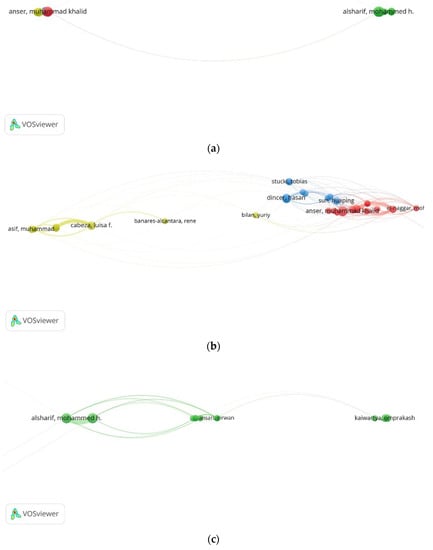
Figure 6. (a) Authors bibliographic coupling map. (b) Authors bibliographic coupling map—clusters 1–3. (c) Authors bibliographic coupling map—cluster 4.
-
The red cluster with 12 authors led by Anser M.K. (Shandong University of Technology, China), Ahmad M. (Super Univ, Pakistan), and Olah J. (University of Johannesburg, South Africa) focuses on financial, technological, and social aspects of green transformation.
-
The blue cluster represented by nine authors, such as Dincer H. (Istanbul Mediapol University, Turkey), Stucki T. (Bern University of Applied Sciences, Switzerland), and Sun H. (Tianjin University of Commerce, China), focuses research on green and renewable energy policy and economics.
-
The yellow cluster covers eight authors including Asif M. (Glasgow Caledonian University, UK), Cabez L.F. (University of Lleida, Spain), and Coma J. (University of Lleida, Spain), whose research focuses on energy aspects of sustainable and green buildings as well as technological aspects of the green transformation.
-
The green cluster includes 11 authors led by Ansharif MA (Sejong University, South Korea), Ansari N. (New Jersey Institute of Technology, US), and Kaiwartya O (Nottingham Trent University, UK), who focus their research on such themes as mobile and cellular networks or sensors for green computing.

Figure 7. Bibliographic coupling of countries.
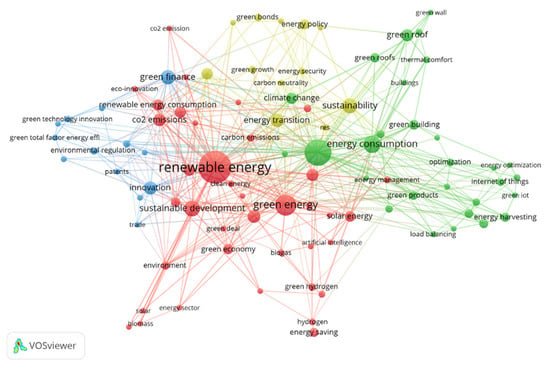
Figure 8. Co-occurrence map (keywords network).
-
The red cluster (38 keywords) encapsulates such terms as renewable energy and green energy followed by sustainable development, CO2 emissions, solar energy, green economy, environmental sustainability, green innovation, renewable energy sources, and technological innovation, which led to the naming of this cluster as “renewable technology innovations”.
-
The green cluster (29 keywords) revolves around the terms energy efficiency and energy consumption, followed by the green roof, green products, climate change, green building, energy harvesting, smart grid, green communication, and optimization, which led to the naming of this cluster as “energy consumption efficiency and sustainability”.
-
The blue cluster (13 keywords) revolves around the terms green finance, innovation, and environmental regulation, followed by patents, green technology innovation, financial development, energy intensity, and environmental policy, which led to the naming of this cluster as “renewable energy innovations ecosystem”.
-
The yellow cluster (12 keywords) revolves around the terms sustainability, energy transition, and economic growth, followed by energy policy, green bonds, green growth, energy security, and carbon neutrality, which led to the naming of this cluster as “renewable energy innovation investments”.
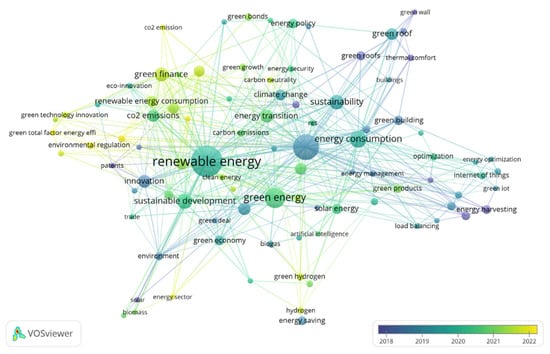
Figure 9. Co-occurrence map (overlay visualization).
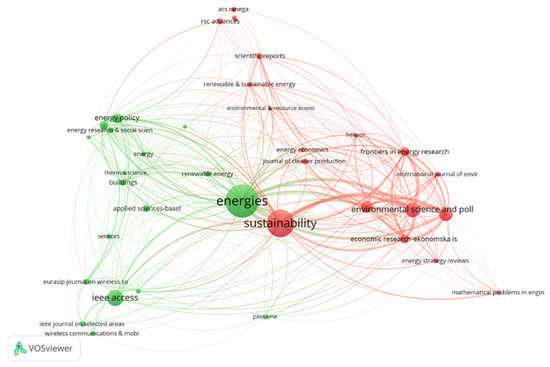
Figure 10. Bibliometric coupling of sources.
